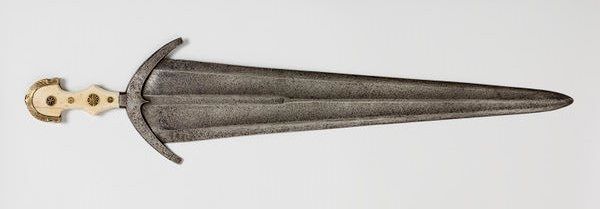Oakeshott Type XXI Renaissance Trifullered Cinquedea Sword
Nov 17, 2013 14:16:32 GMT
Post by Jack Loomes on Nov 17, 2013 14:16:32 GMT

Place of origin: Venice, Italy
Date: 1480 - 1500 (made)
Steel with ivory and pierced and engraved brass
Museum number: 478-1901
Medieval and Renaissance, room 62, case 19
Cinquedea of steel with an ivory hilt mounted in pierced and engraved brass, the blade formerly gilt with traces of etched inscriptions and ornament. The rounded end of the pommel has a brass mount decorated with foliage, the ivory grip is ornamented with four medallions of gothic tracery in brass. The ends of the guard curve towards the wedge shaped grooved blade.
Venice (city), Italy (probably, made)
1480 - 1500 (made)
Steel with ivory and pierced and engraved brass
Marks and inscriptions
'...INVS'
'...VALAR'
Length: 55.7 cm blade, Length: 15.3 cm hilt, Width: 15.6 cm, Depth: 1.8 cm, Weight: 1.04 kg
The sword was formerly in the Raoul Richard Collection in Paris. It was subsequently in the sale of the W.H. Spiller collection at Christie's where it was bought by the Museum via Mr G.R. Harding for £55. Its provenance prior to the 19th century is unknown.
A cinquedea is a sword or dagger bearing a double-edged triangular blade which is very wide at the hilt and generally is frequently fluted in straight lines to the point. The quillons (crossbar to guard the hand) are short and curve slightly towards the blade (in most cases). The name cinquedea is derived from the width of the blade which was supposed to be five fingers wide at the hilt.
The cinquedea was a civilian sword carried horizontally at the back in belt and housed in a leather or cloth-covered scabbard. It was placed horizontally so that it could be drawn easily by the left hand. It was used primarily as a thrusting weapon designed for close combat and self defence.. There are very few variations in form but they were produced in a range of sizes. Most fall between daggers and short swords in length. Many had their blades etched and gilt and a few traces remain on this one.
Cinquedeas were developed in northern Italy particularly around Venice. Florio's 1611 Italian/English Dictionary Queen Anna's New World of Words has "Cinquedita a weapon but fiue fingers long used in Venice".
Cinquedea, the ivory grip mounted in pierced and engraved brass, the blade formerly gilt with etched inscriptions and ornament, Italy (probably Venice), 1480-1500
Bibliographic References (Citation, Note/Abstract, NAL no)
North, Anthony, An Introduction to European Swords, Victoria and Albert Museum, HMSO, London, 1982, ISBN 0 11 290378 9, p. 6, fig. 2 Illustrated and captioned
Coe, Michael D. et al, Swords and Hilt Weapons, Barnes and Noble Books, New York, 1993, ISBN 1-56619-249-8, p. 49 For general history and comparison
Blair, Claude, European and America Arms c.1100-1850, B.T. Batsford Ltd., London, 1962, pp. 4 and fig. 63 For genral history and comparison
Dufty, Arthur Richard, European Swords and Daggers in the Tower of London, HMSO, London, 1974
Stone, George Cameron, A Glossary of the Construction, Decoration and Use of Arms and Armor in All Countries and in All Times, Jack Brussel, New York, 1934, pp. 182-183
Materials: Ivory; Brass; Steel
Techniques: Etching; Carving; Gilding; Forging
Categories: Metalwork; Death; Arms & Armour; Fashion; Accessories
Collection code: MET
For more information on Type XXI Swords see this extract of Ewart Oakeshott's Records of the Medieval Sword: sword-site.com/thread/204/oakeshott-type-records-medieval-sword
Source: collections.vam.ac.uk/item/O97392/cinquedea-unknown/

.png?width=1920&height=1080&fit=bounds)